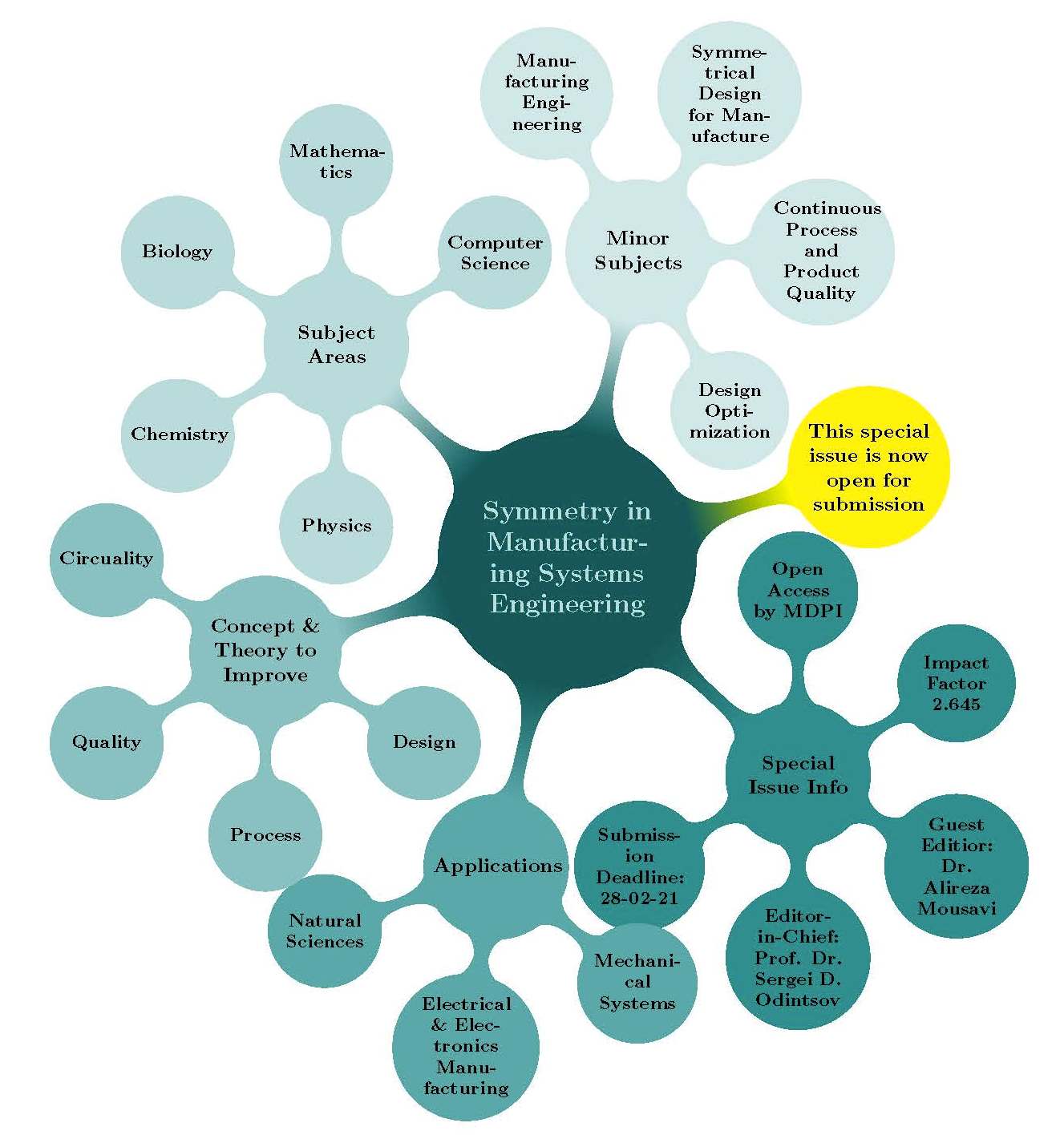Symmetry in Manufacturing Systems Engineering — Concept and Theory to Improve Design, Process, Quality and Circularity as the Basis for Future Manufacturing Philosophy
A special issue of Symmetry (ISSN 2073-8994). This special issue belongs to the section "Engineering and Materials".
Deadline for manuscript submissions: closed (15 August 2022) | Viewed by 35720
Special Issue Editor
Interests: control; manufacturing; engineering; modelling; simulation
Special Issues, Collections and Topics in MDPI journals
Special Issue Information
Dear Colleagues,
Symmetry is a frequent pattern that is widely studied in a variety of fields. Since the first industrial revolution, engineers and scientists have been studying the symmetry of shapes, components, alignments, etc. in industrial manufacturing systems. With the passage of time, various manufacturing processes have attracted attention and brought to light new applications and perspectives of symmetric manufacturing. For example, in mechanical systems and manufacture, symmetric and synchronized systems are often used to satisfy stability criteria for rotating structures; in electrical and electronics manufacturing, the study of symmetrical component faults is a critical issue; in power systems manufacturing, symmetric circuits and networks are essential to guarantee the same data speed/quantity in forward/backward transmission directions. Over time, we can observe a shift from a microscopic angle of seeking symmetrical component/material structures to a macroscopic angle of seeking symmetrical production processes and treatments (e.g., heating, forming, etching, machining, sintering, casting, fusion, and so forth).
This Special Issue of Symmetry features original research papers related to any engineering discipline in which theoretical or practical results of symmetry can be applied to manufacturing systems. We are soliciting contributions covering a broad range of topics including but not limited to: 1) structural symmetries in all kinds of manufacturing engineering (e.g., electronic engineering, mechanical engineering, civil engineering, etc.); 2) symmetrical design for manufacture, disassembly, and circular economy processes; 3) geometric modelling, synthesis, and analysis in manufacturing; 4) continuous process and product quality evaluation through geometric modelling; 5) digital twins of symmetrical materials during production processes and treatments; 6) symmetry and topology of complex networks in engineering; 7) symmetry alignment in quality control and design optimization; 8) symmetry in interdisciplinary complex engineering systems (e.g., agricultural, biomedical, graphical modelling, nanotechnology, robotics, etc.). Review articles related to symmetrical engineering are also encouraged.

Dr. Alireza Mousavi
Guest Editor
Manuscript Submission Information
Manuscripts should be submitted online at www.mdpi.com by registering and logging in to this website. Once you are registered, click here to go to the submission form. Manuscripts can be submitted until the deadline. All submissions that pass pre-check are peer-reviewed. Accepted papers will be published continuously in the journal (as soon as accepted) and will be listed together on the special issue website. Research articles, review articles as well as short communications are invited. For planned papers, a title and short abstract (about 100 words) can be sent to the Editorial Office for announcement on this website.
Submitted manuscripts should not have been published previously, nor be under consideration for publication elsewhere (except conference proceedings papers). All manuscripts are thoroughly refereed through a single-blind peer-review process. A guide for authors and other relevant information for submission of manuscripts is available on the Instructions for Authors page. Symmetry is an international peer-reviewed open access monthly journal published by MDPI.
Please visit the Instructions for Authors page before submitting a manuscript. The Article Processing Charge (APC) for publication in this open access journal is 2400 CHF (Swiss Francs). Submitted papers should be well formatted and use good English. Authors may use MDPI's English editing service prior to publication or during author revisions.
Keywords
- classification by symmetry;
- complex networks and graphs;
- digital twin;
- geometric modelling and optimization;
- design and manufacturing process;
- quality control;
- circular manufacturing;
- symmetry groups and reflection groups;
- symmetry and asymmetry;
- symmetry and synchronization;
- symmetry operations;
- symmetry measures;
- topological symmetry;
- symmetry in complex systems
Benefits of Publishing in a Special Issue
- Ease of navigation: Grouping papers by topic helps scholars navigate broad scope journals more efficiently.
- Greater discoverability: Special Issues support the reach and impact of scientific research. Articles in Special Issues are more discoverable and cited more frequently.
- Expansion of research network: Special Issues facilitate connections among authors, fostering scientific collaborations.
- External promotion: Articles in Special Issues are often promoted through the journal's social media, increasing their visibility.
- Reprint: MDPI Books provides the opportunity to republish successful Special Issues in book format, both online and in print.
Further information on MDPI's Special Issue policies can be found here.





